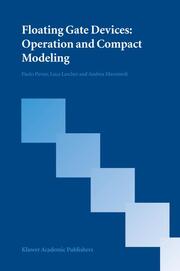Detailansicht
Floating Gate Devices: Operation and Compact Modeling
ISBN/EAN: 9781402077319
Umbreit-Nr.: 1496587
Sprache:
Englisch
Umfang: xv, 131 S., 43 s/w Illustr.
Format in cm:
Einband:
gebundenes Buch
Erschienen am 29.02.2004
Auflage: 1/2004
- Zusatztext
- Floating Gate Devices: Operation and Compact Modeling focuses on standard operations and compact modeling of memory devices based on Floating Gate architecture. Floating Gate devices are the building blocks of Flash, EPROM, EEPROM memories. Flash memories, which are the most versatile nonvolatile memories, are widely used to store code (BIOS, Communication protocol, Identification code,) and data (solid-state Hard Disks, Flash cards for digital cameras,). The reader, who deals with Floating Gate memory devices at different levels - from test-structures to complex circuit design - will find an essential explanation on device physics and technology, and also circuit issues which must be fully understood while developing a new device. Device engineers will use this book to find simplified models to design new process steps or new architectures. Circuit designers will find the basic theory to understand the use of compact models to validate circuits against process variations and to evaluate the impact of parameter variations on circuit performances. Floating Gate Devices: Operation and Compact Modeling is meant to be a basic tool for designing the next generation of memory devices based on FG technologies.
- Kurztext
- InhaltsangabeContributing Authors. Preface. Foreword. 1: Introduction. 1. Compact modeling. 2. Semiconductor memories. 3. Floating gate devices. 4. First commercial devices and products. 5. Evolution. 6. Applications and market considerations. References. 2: Principles of floating gate devices. 1. Technology highlights. 2. Cell operation. 3. Disturbs and reliability. References. 3: DC conditions: read. 1. Traditional FG device models. 2. The charge balance model. 3. Simulation results. References. 4: Transient conditions: program and erase. 1. Models proposed in the literature. 2. The charge balance model: the extension transient conditions. 3. Fowler-Nordheim current. 4. Channel hot electron current. References. 5: Further possibilities of FG device compact models. 1. Reliability prediction. 2. Statistics. References. 6: Non volatile memory devices. 1. Basic elements. 2. Main building blocks of the device. 3. Matrix and decoders. 4. Operating modes. 5. DMA test. Acknowledgement. References. Acknowledgements.
